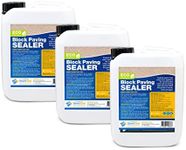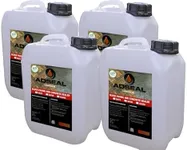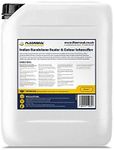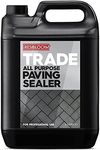Buying Guide for the Best Paver Sealers
Choosing the right paver sealer is crucial for maintaining the appearance and longevity of your paved surfaces. Paver sealers not only enhance the aesthetic appeal of your pavers but also protect them from stains, weather damage, and wear. When selecting a paver sealer, consider the type of pavers you have, the look you want to achieve, and the environmental conditions they will be exposed to. Understanding the key specifications of paver sealers will help you make an informed decision that best suits your needs.Type of SealerPaver sealers come in two main types: film-forming and penetrating. Film-forming sealers, such as acrylics, form a protective layer on the surface of the pavers, enhancing color and providing a glossy or matte finish. Penetrating sealers, like silane or siloxane, soak into the pavers and offer protection without altering the appearance. The choice between these depends on whether you want to enhance the look of your pavers or maintain their natural appearance. If you prefer a shiny, wet look, go for a film-forming sealer. If you want to keep the natural look, a penetrating sealer is the way to go.
FinishThe finish of a paver sealer refers to the appearance it gives to the pavers once applied. Common finishes include glossy, semi-gloss, and matte. A glossy finish provides a shiny, wet look that can enhance the color of the pavers, while a matte finish offers a more natural appearance. Semi-gloss is a middle ground, providing some shine without being too reflective. Consider the aesthetic you want for your outdoor space when choosing the finish. If you want your pavers to stand out and look vibrant, a glossy finish might be ideal. For a more subdued, natural look, opt for a matte finish.
DurabilityDurability refers to how well the sealer can withstand environmental factors such as UV rays, rain, and foot traffic. A durable sealer will last longer and require less frequent reapplication. Sealers with UV protection are particularly important in sunny areas to prevent fading. If your pavers are in a high-traffic area or exposed to harsh weather conditions, look for a sealer known for its durability. This will ensure your pavers remain protected and looking good for a longer period.
Application MethodThe application method of a paver sealer can vary, with options including spray, roller, or brush application. Spray application is often quicker and more even, making it suitable for large areas. Rollers and brushes can provide more control and are ideal for smaller areas or detailed work. Consider the size of the area you need to seal and your comfort level with each method. If you have a large patio, a spray application might save you time. For smaller or intricate areas, a roller or brush might be more appropriate.
Drying TimeDrying time is the period it takes for the sealer to cure and be ready for use. This can range from a few hours to a couple of days, depending on the product and environmental conditions. Faster drying times are convenient if you need to use the area soon after application. However, longer drying times might indicate a more durable finish. Consider your schedule and how soon you need the area to be usable when choosing a sealer. If you need quick results, opt for a sealer with a shorter drying time.















